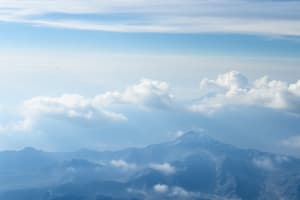Podcast
Questions and Answers
What is the temperature range of the Troposphere?
What is the temperature range of the Troposphere?
- 180 - 275 K
- 200 - 275 K
- 180 - 1473 K
- 280 - 300 K (correct)
Which atmospheric region contains a stable region with less convective mixing due to an increase in temperature and decrease in gas density?
Which atmospheric region contains a stable region with less convective mixing due to an increase in temperature and decrease in gas density?
- Thermosphere
- Stratosphere (correct)
- Mesosphere
- Troposphere
At what altitude does the temperature inversion occur in the atmosphere?
At what altitude does the temperature inversion occur in the atmosphere?
- 50 km (correct)
- 85 km
- 0 km
- 15 km
Which region of the atmosphere is near vacuum with relatively low concentrations of species?
Which region of the atmosphere is near vacuum with relatively low concentrations of species?
What is the principal chemical species in the Mesosphere responsible for photochemical decomposition?
What is the principal chemical species in the Mesosphere responsible for photochemical decomposition?
Which atmospheric region has a homogeneous composition of gases?
Which atmospheric region has a homogeneous composition of gases?
What is the dominant factor in the catalytic decomposition process of O3?
What is the dominant factor in the catalytic decomposition process of O3?
Which compound is a storage product for a while in the ClOx cycle?
Which compound is a storage product for a while in the ClOx cycle?
What is the primary measurement used to quantify ozone depletion potential?
What is the primary measurement used to quantify ozone depletion potential?
Which compound has an ODP of 1?
Which compound has an ODP of 1?
What contributes to greenhouse gases but has a lowered applicability as a replacement compound for CFCs?
What contributes to greenhouse gases but has a lowered applicability as a replacement compound for CFCs?
What can be found in fire retardants and are the bromine analogues of CFCs?
What can be found in fire retardants and are the bromine analogues of CFCs?
What is the primary cause of increased cancer incidents in Asian countries according to the text?
What is the primary cause of increased cancer incidents in Asian countries according to the text?
Which of the following is NOT a principal component of photochemical smog?
Which of the following is NOT a principal component of photochemical smog?
What is the primary source of environmental contamination by arsenic?
What is the primary source of environmental contamination by arsenic?
Which of the following heavy metals is known to inhibit the conversion of ADP to ATP, according to the text?
Which of the following heavy metals is known to inhibit the conversion of ADP to ATP, according to the text?
What is the primary use of tributyltin compounds mentioned in the text?
What is the primary use of tributyltin compounds mentioned in the text?
Which of the following radioactive isotopes is mentioned in the text as a common waste product of nuclear testing?
Which of the following radioactive isotopes is mentioned in the text as a common waste product of nuclear testing?
Which layer of the atmosphere is characterized by intense convection and mixing?
Which layer of the atmosphere is characterized by intense convection and mixing?
What is the temperature range of the stratosphere?
What is the temperature range of the stratosphere?
Which atmospheric region has a temperature inversion at -2 degrees C and 50 km altitude?
Which atmospheric region has a temperature inversion at -2 degrees C and 50 km altitude?
At what altitude does the mesopause reach its lowest temperature of -90 degrees C?
At what altitude does the mesopause reach its lowest temperature of -90 degrees C?
Which atmospheric region is considered near vacuum with relatively low concentrations of species?
Which atmospheric region is considered near vacuum with relatively low concentrations of species?
Which atmospheric compound is an effective filter that absorbs UV radiation in the 200-300 nm range?
Which atmospheric compound is an effective filter that absorbs UV radiation in the 200-300 nm range?
Flashcards are hidden until you start studying




